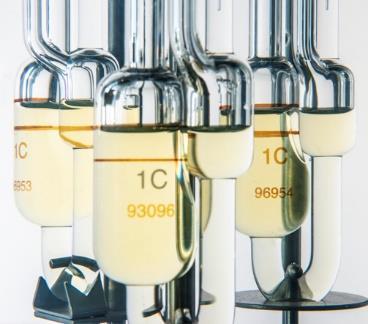Rheotek Polymer Viscometer
Generation 3
Suitable for measuring a wide range of polymers, cellulose, pulp, inks and other liquids.
PA, PET, PVC, PAN, PLA, PB, PC, PE, PP, pulp, cellulose, MCC, electrical papers
Automated Polymer Viscometer
The Rheotek Polymer Viscometer – RPV Generation 3 – provides a reliable and precise method for measuring dilute solution viscosity.
In this very operator sensitive test, automation using the RPV minimizes the variability of results.
Reported results include:
Kinematic Viscosity
Dynamic Viscosity
Relative Viscosity
Specific Viscosity
Reduced Viscosity
Viscometer Number
Inherent Viscosity
Intrinsic Viscosity
K-Value
Rheotek Polymer Viscometer
Generation 3
The RPV is a modular viscometer system. The generation 3 consists of a Viscometer Control Module with the latest embedded electronics, Temperature Control Module with solid state components, measuring heads (for optical sample detection), vacuum pump, PC and software platform.
Additional system options include the Rheotek Smart Sampler, reaction blocks for heating, stirring and cooling as well as other essential options for dilute solution viscosity.
A complete starter kit can be supplied for PVC, PA, PET and rPET, as well as other applications.
Poulten Selfe & Lee Ltd www.psl-rheotek.com
Rheotek Polymer Viscometer with 2 measuring positions and optional diaphragm vacuum pump
iSP-1 Sample Preparation
Auto sampler with heating & Stirring blocks
RPV System Configurations
Three levels of system automation
• Standard RPV systems – automation of flow time measurements, calculation of results and in-situ cleaning and drying plus iSP, SD1BM options below.
• RSS systems as above with automated sample delivery using a XYZ auto sampler, plus iSP and SD-1BM options below.
RPV Options
SD-1BM blocks with an optional chiller
• Auto systems as above with integrated sample preparation, sample dissolution, and sample delivery
Integrated Sample preparation
Standard and RSS systems can be combined with the optional integrated sample preparation (iSP) –this automates the preparation of samples on a weight-to-weight basis, providing a precise concentration of the polymer.
The iSP consists of a precision balance, syringe pump for dispensing solvent as well as the iSP software. The iSP software can be used standalone or in conjunction with the RPV software.
Sample dissolution
Sample dissolution can be carried out in a standalone 8 station reaction block (SD-1BM). This provides stirring as well as heating, together with the option of integrated cooling or the use of a quenching bath.
The iSP-1 and SD-1BM are built into auto systems.
Additional options are available according to the polymer application, including a purpose built fume hood to accommodate the RPV system.
iSP-1 with precision balance
Software
The RPV software is designed to be user friendly and flexible. The software is highly configurable allowing optimisation for a wide range of applications. Results can be networked, interfaced to LIMS or generated in a home page and pdf result.
New to solution viscosity?
For a customer setting up solution viscosity for the first time, PSL Rheotek can provide a tailor-made package, including:
- Polymer Viscometer, Sample Preparation
- Reaction blocks for heating and stirring
- Quenching bath or chiller
- Hot plates
- Precision thermometer
- Custom fume hoods to accommodate the complete system
Polymer Sample Testing
The PSL Rheotek Polymer Laboratory offers a testing service for a wide range of polymers. Testing is carried out in accordance with international methods and a detailed report will be supplied.
















